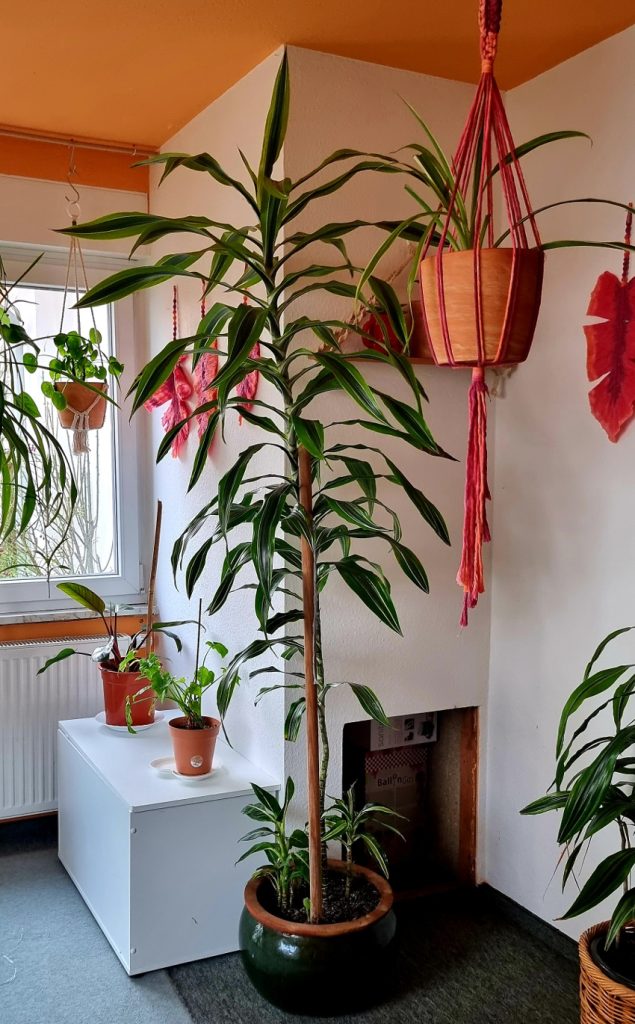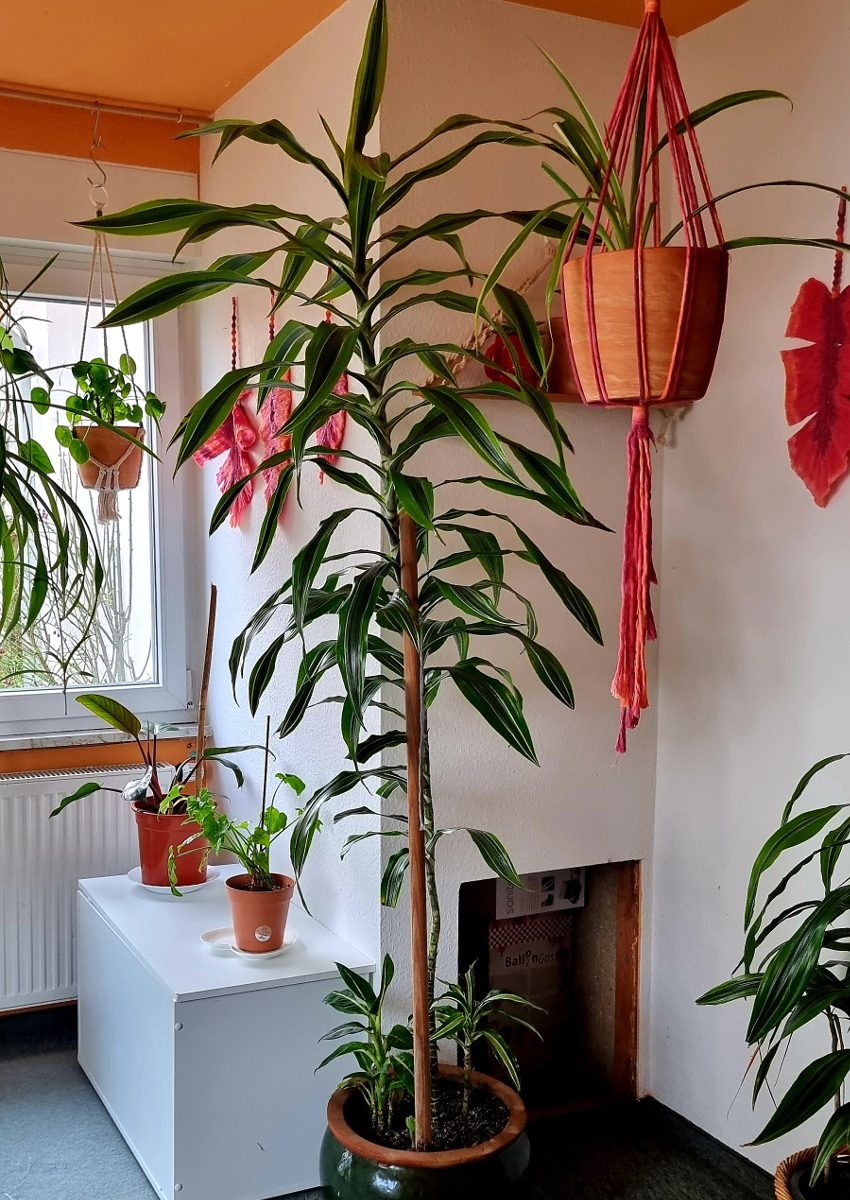Do you wish to add a tropical ambiance to your home ? If you do, it’s time to beautify your space with the beautiful underrated tropical plant, the Dracaena Elegans or Lemon-Lime Plant.
General background
Dracaena Elegans is a tropical plant native to Sudan, Mozambique, the Ivory Coast, and Angola. It’s also commonly referred to as the Dragon Tree ‘Lemon-lime’ plant or Cornstalk Dracaena because of its slender and stemmy body. In nature, the Cornstalk Dracaena plant is bright green, but cultivars come in a wide range of colors, including the lemon-lime species. As the name suggests, its lanced-shaped leaves consist of broad stripes of lime green on the border and dark green at the center, with a fine white line separating both contrasting colors. Its easy-to-care-for and eye-catching features have made it the perfect room highlighter that can also be grown in the comfort of your homes and offices.

But how can you grow and care for your Dracaena Elegans ?
Dracaena plants, in a nutshell, are not demanding, but before we dive into its care, you’ll need to sort out a suitable spot for it.
- Where to Place your Dracaena lemon-lime plant
- Additional care guide
- Frequently asked Questions
- Other Species of Dracaena
Where to Place your Dracaena lemon-lime plant
Dracaena plants are hardy tropical plants that require sufficient light, room temperature, and space to flourish if you want them to attain several meters. However, you can grow cultivars such as lemon-lime in indirect or filtered light because direct sunlight will cause leaf burns, while inadequate light will lead to stagnation and browning of its foliages. Southwestern and Eastern exposed windows will be optimal for your Dracaena lemon-lime, but it must be a few meters away from the window or behind a curtain.
If you’re still uncertain about the lighting need of your plants, then we suggest you use a light meter.
Additional Tip
Dracaena plants will grow best in humid environments, therefore, it’s advisable to position your plants away from heaters to avoid foliage damage and pest growth. Don’t forget to regularly mist their leaves with diluted Neem Oil to keep them clean, increase humidity levels, and prevent pests.
Supposing you’ve figured out the optimal spot for your Dracaena lemon-lime, how do you care for it so that it flourishes ?
Additional Care Guide
The German saying goes, ”The dumbest farmers have the biggest potatoes.” In light of that, you don’t need to be a pro gardener to nurture and grow flourishing Dracaena plants.
Unlike most tropical houseplants that demand a lot of care and attention, the Dracaena Lemon-Lime falls in the easy-to-care-for category. Their basic needs include planting them in a well-draining potting medium (pH 6.6 – 8.0) and watering them sparsely. Avoid water-retaining mediums because the constant moist soils will lead to root rot and browning of the tips of your foliages.
Water your Dracaena after conducting a finger check. If your index finger comes out dry, it’s time to rehydrate your plant. Please also use a watering can to efficiently disperse the water, aiming to reach all the corners. Also, opt for planters with drainages to avoid water from accumulating, and the results will be root rot.
As your Dracaena plant matures, you will need to water it frequently. If their water demands increase, it is a sign that you need to repot.
Switch to other water sources (rain or filtered water) if the water in your vicinity is hard. Hard water will cause browning tips in your plant and disintegrate your terracotta in the long run.
Furthermore, if your Dracaena plant grows tall so that a moss pole can’t support its weight, prune it down (when pruning down your plant, ensure that the cut is smooth and done with sterile tools). After a few weeks, you’ll begin to notice two or three shots of young dracaena plantlets emerging from the sides of the pruned trunk. Over time, your plant will grow to become bushier and healthier, a dream come true for plant parents.
Additional Tips
Dracaena plants will benefit from an all-around liquid fertilizer during the growing seasons (March – August). Please follow the instructions on the label of your fertilizers.
Frequently asked Questions
Why are the tips of my Dracaena lemon-lime turning yellow ?
Dracaena Plants, Spider Plants, and other palms like Yucca Palms, watered with hard water and over or under fertilized, will suffer the fate of browning tips. Luckily, you can quickly fix it by following the instructions on the fertilizer and switching to filtered water or rainwater. Also, Aerate your potting mediums with perlite or a moss pole to prevent water retention.
Why is my Drcaena not growing ?
Dracaena plants are naturally slow growers, but if a new leaf doesn’t sprout within three months, the probable causes are insufficient light or malnutrition. Therefore, the appropriate solution will be to provide them with more light or supplement them with grow lights and apply a nitrogen-based fertilizer.
I spotted a fungus gnat flying around my plant ! What should I do ?
Fungus Gnats are attracted to moisture, light, and unhealthy plants. If you spot a fungus gnat flying around your plant, the first thing to do is to recheck your watering routine. Also, top your mediums with coarse sand or stones and regularly mist with diluted neem oil to prevent their spread.
Can I propagate my Dracaena ? If yes, how should I proceed ?
Yes, you can propagate a Dracaena by following these easy steps.
But before we get to the details, you’ll require rainwater, a sterile pair of scissors, and a vase.
Procedure:
- Ensure that your plant is healthy and mature (a healthy cutting guarantees a successful propagation).
- Locate an area along the stem of your plant (your cutting should at least be 50cm long)
- Using a sterile pair of scissors or knife, make a smooth cut around its stem.
- Take off a few leaves, leaving a maximum of three or four hanging.
Finally, fill the rainwater into the vase and place the cutting. In three to four weeks, roots should sprout, and you can finally pot your plant. OR immediately replant your cuttings into the planter of the parent plant. The catch is, you’ll miss the fun of watching your cuttings develop roots in water.
How often do I need to water my Dracaena Lemon-Lime ?
There is no general rule about the number of times you need to water your Dracaena because it depends on your location and season of the year, but from personal experience, I rehydrate my Dracaenas once every 14 days in Autumn and Winter and once every seven days in Spring and Summer. Before proceeding, I always carry out a ‘finger wetness’ test to be sure.
You proceed by dipping your index finger as far as it gets into the potting medium, if it comes out dry, it’s time to quench your plant’s thirst.
Find out more about the various ways to prevent and eradicate plant pests and diseases in houseplants.
Other species of Dracaena
- Dracaena Fragrans ‘White Jewel’
- Dracaena Reflexa ‘Anita’
- Dracaena Reflexa ‘Song Of India’
- Dracaena Marginata ‘Dragon Tree’
- Dracaena Deremensis
- Dracaena Fragrans ‘Hawaiian Sunshine’
- Drcaena Surculosa ‘Florida Beauty’
Bonus Check
Have you implemented the above suggestions, but your plant still won’t grow healthy and tall ? Well, it’s not because you are doing something wrong. Plant pests and diseases might be spitting in your soap.
Plant Pests and Diseases are rare in Dracaenas, but they might affect them. Sometimes spotting a mealybug or leaf louse is almost impossible because they hide the gaps between the trunk and foliages. Such dark corners provide optimal conditions for nourishment and warmth. If pests like mealybugs or Fungus gnats continue to grow and reproduce unnoticed, they will cause extensive and irreparable damage to the plant in the long run. All hope is not lost, and you still stand a chance to eradicate them with Neem Oil at an early stage of development.
Additional Tip
You can use Neem Oil to prevent a wide range of plant pests such as mealybugs, scales, fungus gnats, spider mites, root bugs, and other aphids, but you must dose it properly to get maximum results.
You are a good plant parent, so pat yourself on the back and tell your Dracaena, “Grow, baby, grow !” 🙂


I was just telling my friend about that.
Wonderful views on that!